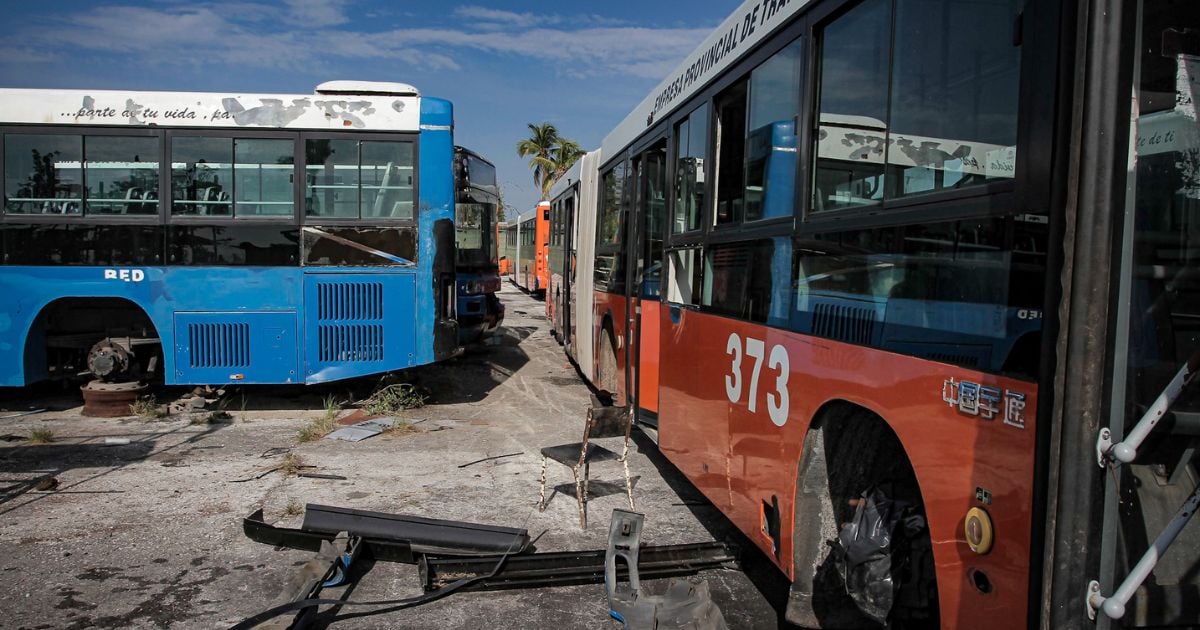In a bid to revive 100 public buses in Havana, the Cuban regime is spearheading a project that leverages used parts and a significant donation from the Chinese government. These buses, which have been inactive at various terminals across the capital for an extended period, are currently undergoing repairs at CAISA workshops in Guanajay. This update was shared by the Minister of Transport, Eduardo Rodríguez Dávila, on Facebook during his visit to oversee the progress.
The project aims to restore 60 rigid and 40 articulated buses, with repairs encompassing everything from bodywork and painting to the mechanics of various systems. One of the "necessary" solutions, as highlighted by the minister, involves creating more durable seats, which are among the parts most susceptible to wear and tear due to constant use.
To expedite the refurbishment, parts such as glass panels, electrical components, gearboxes, and engines that still have a useful life are being reused. Many of these components are sourced from dismantled vehicles, a process the minister acknowledged as being marked by the "cannibalization" these units have suffered over years of neglect. The recovery of engines has been one of the most challenging aspects. Currently, there are 100 engines available, and assessments are underway to determine which can be repaired and which need to be decommissioned, in coordination with Motor Centro.
New parts and modules donated by China are expected to arrive in two phases by August. These contributions will enable the completion and deployment of more buses before the year's end, according to the minister. This initiative is also supported by the Public Transport Development Fund, which is financed through vehicle sales, aiming to alleviate the transportation crisis in Havana, exacerbated by a lack of foreign currency, fuel, lubricants, and spare parts, as acknowledged by the transport minister.
The official tour also covered the UEB Logistics of the Provincial Transport Company Havana, revealing the dire state of daily maintenance: machines that should operate automatically are functioning manually due to technical failures, while low salaries and disorganization add to the technical staff's challenges. Rodríguez noted "modest progress" but acknowledged numerous obstacles, committing to ongoing updates on efforts to revive the capital's public transport system.
The deterioration of Cuba's public transport system has been recognized even by the authorities, who have described the situation as a true collapse. Recently, the government admitted the severity of the issue, citing shortages of spare parts, fuel, and vehicles as critical factors. Official figures paint a grim picture: only 252 buses were operational in Havana, while 309 were out of service, highlighting the regime's inability to maintain the country's basic infrastructure.
Similarly, the government confirmed that Cuban Railways is on the brink due to a lack of essential parts. This crisis not only impacts urban and interprovincial mobility but also freight transportation, creating a domino effect on the already fragile national economy. The Ministry of Transport has admitted that the railway service lacks the necessary resources to ensure the regular operation of its routes, with many locomotives and wagons remaining inactive due to unresolved technical issues.
As part of a social control campaign in response to the growing transport deterioration, authorities called on the public to report acts of vandalism against public transport. Adding to this chain of events was an extraordinary incident earlier this month when a train came to a halt after running out of fuel, causing traffic chaos. This incident, which went viral on social media, underscores the extent of the system's collapse, affecting thousands of citizens who rely on public transport daily for work, education, and essential services.
Revitalizing Havana's Public Transport: Key Questions Answered
What is the current state of public transport in Havana?
The public transport system in Havana is in a state of crisis, with only 252 buses operational and 309 out of service. Authorities have acknowledged the severe shortages of spare parts, fuel, and vehicles.
How is the Cuban government addressing the transport crisis?
The Cuban government is attempting to mitigate the transport crisis by restoring buses using used parts and donations from China, along with support from the Public Transport Development Fund.
What challenges are faced in the bus restoration project?
The project faces challenges such as the recovery of engines, the need for durable seats, and the reuse of parts from dismantled vehicles, all complicated by years of neglect and limited resources.
What role do Chinese donations play in this effort?
Chinese donations, arriving in two phases by August, include new parts and modules crucial for completing and deploying more buses by the end of the year.
